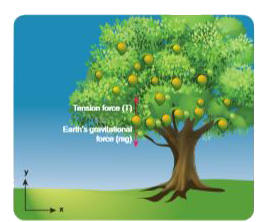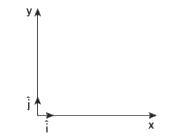Apply Newton’s second law to a mango hanging from a tree. (Mass of the mango is 400 gm)
Note: Before applying Newton’s laws, the following steps have to be followed:
1) Choose a suitable inertial coordinate system to analyse the problem. For most of the cases we can take Earth as an inertial coordinate system.
2) Identify the system to which Newton’s laws need to be applied. The system can be a single object or more than one object.
3) Draw the free body diagram.
4) Once the forces acting on the system are identified, and the free body diagram is drawn, apply Newton’s second law. In the left hand side of the equation, write the forces acting on the system in vector notation and equate it to the right hand side of equation which is the product of mass and acceleration. Here, acceleration should also be in vector notation.
5) If acceleration is given, the force can be calculated. If the force is given, acceleration can be calculated.

By following the above steps:
We fix the inertial coordinate system on the ground as shown in the figure

The forces acting on the mango are
i) Gravitational force exerted by the Earth on the mango acting downward along negative y axis
ii) T ension (in the cord attached to the mango) acts upward along positive y axis.
The free body diagram for the mango is shown in the figure.

→Fx=mg(−ˆj)=−mgˆj
Here, mg is the magnitude of the gravitational force and (−ˆj) represents the unit vector in negative y direction.
→T=Tˆj
Here T is the magnitude of the tension force and (ˆj) represents the unit vector in positive y direction.
→Vnet=→Fg+→T=−mgˆj+T→j=(T−mg)ˆj
From Newton’s second law →Fnet=m→a
Since the mango is at rest with respect to us (inertial coordinate system) the acceleration is zero (→a=0)
So →Fnet=m→a=0
(T−mg)ˆk=0
By comparing the components on both sides of the above equation, we get T mg −= 0
So the tension force acting on the mango is given by T mg
Mass of the mango m = 400g and g=9.8ms−2
Tension acting on the mango is T=0.4×9.8=3.92N
Topper's Solved these Questions
- LAWS OF MOTIONBOOK - NCERT TAMILCHAPTER - LAWS OF MOTIONEXERCISE - EXERCISE ( I. Multiple Choice Questions)
15 Videos
- LAWS OF MOTIONBOOK - NCERT TAMILCHAPTER - LAWS OF MOTIONEXERCISE - EXERCISE (V. Numerical Problems)
14 Videos
- LAW OF MOTIONBOOK - NCERT TAMILCHAPTER - LAW OF MOTIONEXERCISE - EXERCISE (ADDITIONAL EXERCISE)
17 Videos
- MECHANICAL PROPERTIES OF FLUIDS BOOK - NCERT TAMILCHAPTER - MECHANICAL PROPERTIES OF FLUIDS EXERCISE - EXERCISE
45 Videos
Similar Questions
Knowledge Check
When a mango falls from a mango tree then
AOnly the earth attracts the mangoBOnly the mango attracts the earthCBoth mango and earth attract each otherDBoth repel each otherA mango tree is at the bank of a river and one of the branch of tree extends over the river. A tortoise lives in the river. A mango falls just ono the tortoise. The acceleration of the mango falling from tree as it appears to the tortoise is (refractive index of water is 4/3 and the tortoise is stationary)
AgB3g/4C4g/3Dnone of these
From Newton's second law of motion, it can be inferred that
View SolutionWhen a mango falls from a mango tree then
View SolutionA mango tree is at the bank of a river and one of the branch of tree extends over the river. A tortoise lives in the river. A mango falls just ono the tortoise. The acceleration of the mango falling from tree as it appears to the tortoise is (refractive index of water is 4/3 and the tortoise is stationary)
View SolutionA mango tree is at the bank of a river and one of the branch of tree extends over the river. A tortoise lives in the river. A mango falls just ono the tortoise. The acceleration of the mango falling from tree as it appears to the tortoise is (refractive index of water is 4/3 and the tortoise is stationary)
View SolutionHow can Newton.s first law of motion be obtained from the second law of motion?
View SolutionState the Newton's second law of motion and deduce the Newton's first law from it.
View Solution
